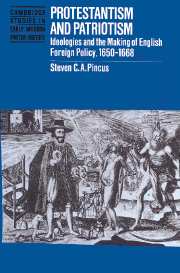Book contents
- Frontmatter
- Contents
- Acknowledgments
- List of abbreviations
- 1 Introduction
- Part I The rod of the Lord: ideology and the outbreak of the First Anglo-Dutch War
- Part II To unite against the common enemy: the 1654 Treaty of Westminster and the end of apocalyptic foreign policy
- 5 Historiographical overview
- 6 The causes of the war stated
- 7 Peace proposed
- 8 Political upheavals and ideological divisions
- 9 The rejection of apocalyptic foreign policy
- 10 The Protectorate's new foreign policy
- Part III Popery, trade, and universal monarchy: ideology and the outbreak of the Second Anglo-Dutch War
- Part IV The Medway, Breda, and the Triple Alliance: the collapse of Anglican Royalist Foreign Policy
- Conclusion
- Bibliography
- Index
- Titles in the series
10 - The Protectorate's new foreign policy
Published online by Cambridge University Press: 01 October 2009
- Frontmatter
- Contents
- Acknowledgments
- List of abbreviations
- 1 Introduction
- Part I The rod of the Lord: ideology and the outbreak of the First Anglo-Dutch War
- Part II To unite against the common enemy: the 1654 Treaty of Westminster and the end of apocalyptic foreign policy
- 5 Historiographical overview
- 6 The causes of the war stated
- 7 Peace proposed
- 8 Political upheavals and ideological divisions
- 9 The rejection of apocalyptic foreign policy
- 10 The Protectorate's new foreign policy
- Part III Popery, trade, and universal monarchy: ideology and the outbreak of the Second Anglo-Dutch War
- Part IV The Medway, Breda, and the Triple Alliance: the collapse of Anglican Royalist Foreign Policy
- Conclusion
- Bibliography
- Index
- Titles in the series
Summary
In early December 1653, the Nominated Parliament granted the Dutch deputies their passports in recognition that their negotiation had failed. Cromwell and his more moderate colleagues, however, hinted to the Dutch that they should hold out a bit longer, that a change of government was imminent. The Dutch knew that it was the radical members of the Nominated Parliament and their fiery preachers who had obstructed the negotiations. Cromwell, Hugh Peter, and many of the commissioners had made it clear to the Dutch deputies that their hands were tied by the temporary ascendancy of the radical millenarians. However, the Dutch were convinced, as were most political observers, that the situation could not last for long, that Cromwell would put an end to this Parliament just as he had dissolved the Rump. A new regime, especially a new regime which was not so deeply influenced by Thomas Harrison and the hot men of St. Anne's Blackfriars, would certainly be more amenable to peace.
Sure enough, as soon as the Nominated Parliament submitted its resignation and the Protectorate was proclaimed, the prospects for peace were dramatically transformed. Cromwell immediately sent word to the Dutch deputies “that now he is advanced to a quality fit to treat with them” assuring them “of his desires of peace.” “There is probability of peace with the Dutch,” trumpeted the Several Proceedings of State Affairs. The bookstalls in London were filled with copies of The Peace-Maker which outlined the benefits of an Anglo-Dutch alliance.
- Type
- Chapter
- Information
- Protestantism and PatriotismIdeologies and the Making of English Foreign Policy, 1650–1668, pp. 168 - 192Publisher: Cambridge University PressPrint publication year: 1996



